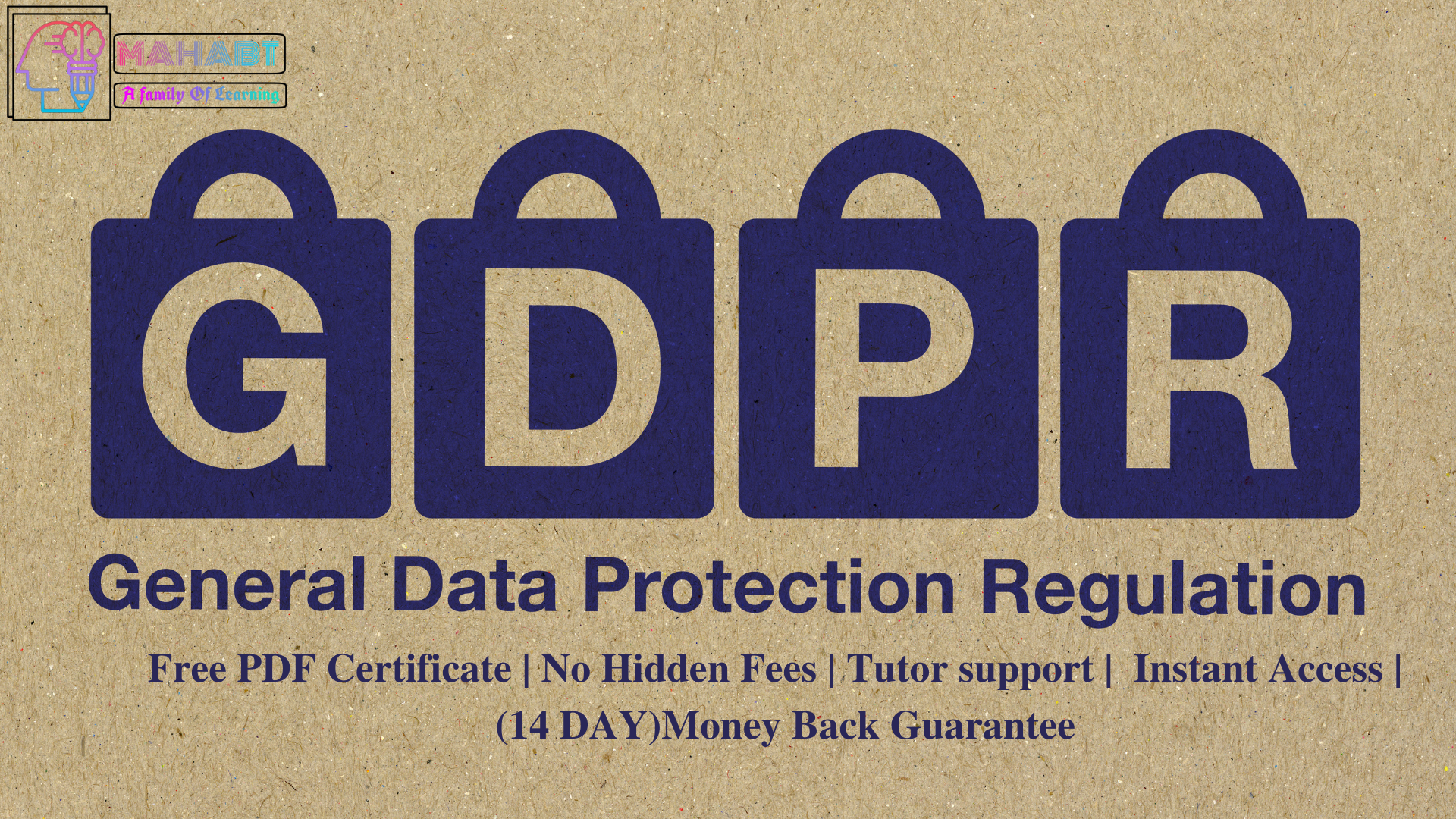GDPR – General Data Protection Regulation

About Course
PDF Course
The General Data Protection Regulation (GDPR) is a piece of EU legislation that lays out the guidelines for how companies and other types of organisations are supposed to manage their customers’ data. The term “personal data” refers to any information that may be used to either directly or indirectly identify a specific individual. Your name, phone number, and address are all examples of information that may be used to identify you personally. Information that may be used to directly or indirectly identify a single individual is considered personal data. Examples of this type of information include a person’s preferences, purchases, health conditions, and activities conducted online. Existing data protection rules across the European Union needed to be strengthened and unified. Thus legislation known as the General Data Protection Regulation (GDPR) was passed. By placing a focus on individuals’ right to privacy, the General Data Protection Regulation (GDPR) aims to safeguard citizens against the inappropriate use of their data. Because of the serious repercussions that can result from a violation of the GDPR’s laws and regulations, enterprises, firms, and other organisations need to be informed about them. We will go through the responsibilities and rights of DPOs, as well as explore the roles that DPOs are expected to play and the expectations placed on them (DPOs). In this course, we will discuss the individual rights and freedoms that people are entitled to when it comes to their personal data, as well as how to maintain compliance with GDPR rules and regulations. This will be accomplished by outlining the individual rights and freedoms people are entitled to regarding their personal data. Because of the serious repercussions that can result from a violation of the GDPR’s laws and regulations, it is essential for enterprises, firms, and other organisations to be informed about them.
The General Data Protection Regulation (GDPR) will also be covered, along with some examples of how businesses can comply with GDPR guidelines and best practices. These examples will include the implementation of certain measures, such as the minimisation and anonymisation of personal data, the provision of clear consent regarding the use of collected data, and the implementation of proper security measures to ensure the safety and privacy of all customers’ data.
This GDPR course has been broken down into 12 modules that each focus on a different key aspect of GDPR. The course aims to provide students with knowledge of the industry and the skills necessary to advance their careers in this field. You will be equipped with the necessary proficiency for GDPR once you have successfully completed the course.
If you are interested in gaining a comprehensive understanding of GDPR, you should enrol in our GDPR course.
GDPR
Module 1: Data Privacy Origins and Concepts
- Data Privacy Issues and Challenges
- The Problem of Voluntary Information
- Privacy-As-Trust Vs Notice-and-Choice
- Privacy’s Origins in Europe and the Commonwealth
- Invasion of Privacy in the Digital Age
- Personal Privacy as an Extension of Data
Module 2: Brief introduction to GDPR
- What is personal data?
- What is GDPR?
- What are the most important principles that govern data protection?
- The supervisory authority?
- What exactly are the goals of the General Data Protection Regulation (GDPR)?
- Key GDPR terminology
Module 3: General Data Protection Regulation Explained
- History Of GDPR
- Key change?
- What are the law’s specifications?
- The structure of GDPR
- Organisational Structure
Module 4: Lawful Basis for Preparation
- Why is the Lawful Basis Important?
- Six Lawful bases of processing personal data
- How to identify the proper legal basis
- Information Relating to Exceptional Categories / Crimes
- Documentation and File Maintenance
- Documentation of all kinds is required.
- To Have a Reasonable Concern
Module 5: Rights and Breaches
- Exactly who is the Data Subject?
- Rights of Data Subjects
- Handling Children data
- Individual Rights
- The Right to restrict processing
- How to adhere to the law
- Breach of Notification
Module 6: Responsibilities and Obligations
- Accountability
- The Responsibilities of the data protection officer
- Duties of the information commissioner
- Why GDPR law is vital for you and your company
- The Roles of Data Controllers and Data Processors Under the General Data Protection
- Regulation
- Deadline and Consequences for the Business
- GDPR penalties and fines
Module7: Practical Implementation of the Requirements Under the GDPR
- Step 1: ‘Gap’ Analysis
- Step 2: Risk Assessment
- Step 3: Project Management and Budget Planning
- Step 4: Implementation
- Constant monitoring and maintenance
Module 8 Governmental Use of Data
- Member State Legislations
- Processing in the “Public Interest”
- Processing on the basis of public interest
- Use of “Special” Data by States
- Processing of Criminal Records Data
- The Public Interest and a Data Subject’s Rights
- Data Mobility
- The right to object
- Explanation Rights
- Data and documents made public.
- GDPR Restrictions in the Public Interest
Module 9 Data Protection Authority
- Supervisory Authority
- Suspicion of a breach
- Violations That Have Been Proven
- Harsh Restrictions
- The Imposition of Penalties
Module 10 Security and breach notification
- Concepts in current (GDPR) security
- Maintain the safety of the information you handle.
- Notification of a security breach
- Outlook
Module 11: Key Requirements of the GDPR
- Recordkeeping:
- Data Protection Officers
- Data Protection Impact Assessments
- Privacy by Design and Default
- GDPR and Straightforwardness
- Permission-Based on Informed Consent or Another Legal Basis for Processing
- Cybersecurity
- 72-Hour Breach Notifications
Module 11 : Data Mapping
- Data Mapping: What Is It?
- What is a Data Inventory?
- Manual vs Automated Data Maps?
- External vs Internal Data Detection
Module 12: Consent Under GDPR
- What is the GDPR Consent Definition?
- How is Consent Obtained?
- What Format Is Required for Requests to Gain Consent?
- What are the Other Considerations in Obtaining Consent?
- To what extent may I rely on consent as a legal basis for processing, and what documentation do I need to provide?
- The Use of GDPR Consent in Real Life
Course Content
Module 1: Data Privacy Origins and Concepts
-
Data Privacy Origins and Concepts
00:00
Module 2: Brief introduction to GDPR
Module 3: General Data Protection Regulation Explained
Module 4: Lawful Basis for Preparation
Module 5: Rights and Breaches
Module 6: Responsibilities and Obligations
Module 7: Practical Implementation of the Requirements Under the GDPR
Module 8 Governmental Use of Data
Module 9: Data Protection Authority
Module 10: Security and breach notification
Module 11: Key Requirements of the GDPR
Module 12: Consent Under GDPR
Module 13: Data Mapping
Student Ratings & Reviews

